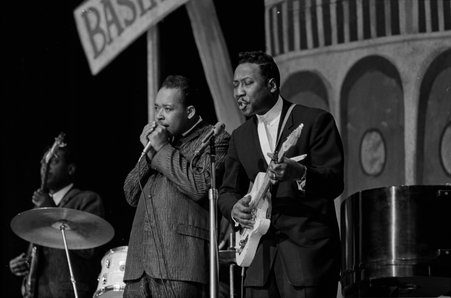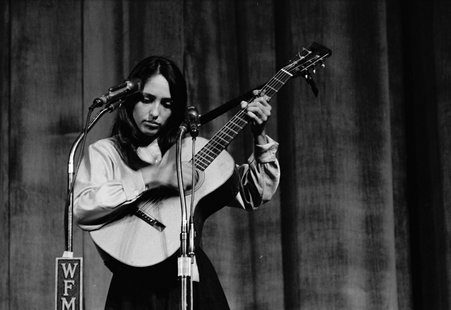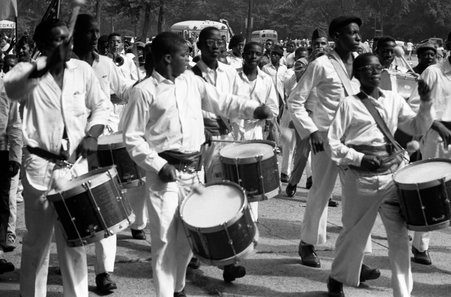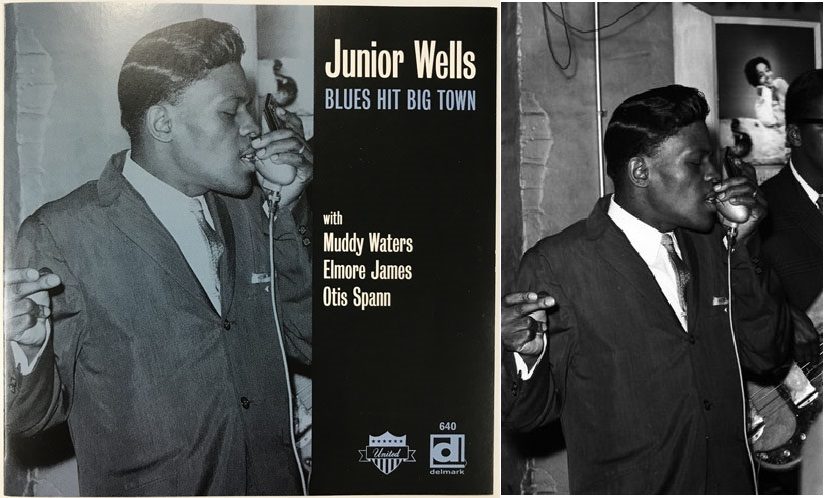Collections volunteer Robert Blythe writes about photographer Raeburn Flerlage, who captured the blues and folk scenes in 1960s Chicago.
If you’re a fan of American roots music, then the Chicago History Museum’s Raeburn Flerlage collection is a must-see. Ray, as he was known, spent much of the 1960s taking candid photographs in Chicago’s premier blues and folk clubs. The thousands of images that he took are an incredible record of two outstanding and influential genres of American music: the urban blues and the folk revival. At clubs on the South and West Sides such as Theresa’s and Pepper’s, Flerlage captured legendary electric blues musicians including Muddy Waters, Howlin’ Wolf, and Buddy Guy. In these intimate settings, audience response was an integral part of the performance, and it shows in his photographs.

James Cotton (left) and Muddy Waters (with guitar) perform in Jazz at the Opera House, Chicago, 1963. ICHi-137738
During that same period, the folk revival was taking off at festivals and Chicago venues such as The Gate of Horn and the Plugged Nickel. Among the artists to be heard were Pete Seeger, Bessie Jones, and Joan Baez, as well as rediscovered rural blues icons such as Son House. Flerlage photographed these musicians and dozens of others.

Folk singer Joan Baez performs in Chicago, c. 1962. ICHi-118329
In the late 1950s, Flerlage became interested in photography, taking courses at the School of the Art Institute of Chicago and the Institute of Design. In 1959 he got his first professional assignment: Moe Asch of Folkways Records commissioned him to photograph one of the label’s artists, bluesman Memphis Slim. Before long Flerlage’s photographs were appearing widely on album covers, in books and magazines, eventually even on T-shirts. Flerlage also didn’t confine his photography to musicians; he documented community events such as Chicago’s annual Bud Billiken Day Parade.

A drum corps performs in the Bud Billiken Parade, Chicago, c. 1960. ICHi-112491
While Flerlage is better known for his photography, he was involved in many aspects of the music business. He began in his twenties in Ohio, selling records and writing reviews. At the end of World War II, Flerlage moved to Chicago, continuing to write and also lecture on music. Soon he was organizing concerts and producing and hosting radio programs. These varied activities didn’t pay the rent, so in 1955 he became the Midwest sales representative for a number of independent record labels, including Folkways, Prestige, and Chicago’s Delmark. And later, with fewer opportunities to make money through photography, he went into record distribution on his own, forming Kinnara Inc. in 1971.

The cover image for Junior Wells’s Blues Hit Big Town (1977) is a slightly altered photograph of him performing at Theresa’s, Chicago, October 1965. ICHi-133642
Raeburn Flerlage passed away in 2002 at the age of eighty-seven. Some 45,000 photographic images form the core of the Flerlage collection, which is now available to researchers thanks to a processing grant from The Gladys Krieble Delmas Foundation. Also available are extensive business and personal records that reveal his progress through the music business in the twentieth century. Moreover, the holdings of the Museum’s Research Center have been greatly enhanced by Flerlage’s personal collection of blues and jazz reference books as well as publications from the late 1950s through the 1960s featuring his music reviews or photographs, such as Sing Out!, DownBeat, and the rare Chicago FM Guide.
A selection of Flerlage’s photographs will be featured in an upcoming exhibition, Amplified: Chicago Blues, which opens on Saturday, April 7. The exhibition will provide the perfect opportunity to view some of his work, as well as one of the city’s greatest legacies: the electric blues.
Join the Conversation